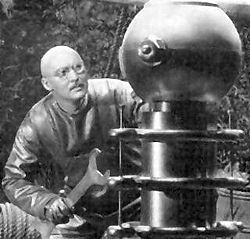| Dr. Cyclops | |
|---|---|
 | |
| Directed by | Ernest B. Schoedsack |
| Written by | Tom Kilpatrick Malcolm Stuart Boylan (uncredited) |
| Produced by | Dale Van Every Merian C. Cooper |
| Starring | Albert Dekker Thomas Coley Janice Logan Charles Halton Victor Kilian |
| Cinematography | Henry Sharp |
| Edited by | Ellsworth Hoagland |
| Music by | Gerard Carbonara Albert Hay Malotte Ernst Toch |
| Color process | Technicolor |
Production company | |
| Distributed by | Paramount Pictures |
Release date |
|
Running time | 77 minutes |
| Country | United States |
| Language | English |
Dr. Cyclops is a 1940 American science fiction horror film from Paramount Pictures, produced by Dale Van Every and Merian C. Cooper, directed by Ernest B. Schoedsack, and starring Thomas Coley, Victor Kilian, Janice Logan, Charles Halton, Frank Yaconelli and Albert Dekker. [1]
Contents
The film was nominated for an Oscar for Best Visual Effects (by Farciot Edouart and Gordon Jennings) at the 13th Academy Awards. [2]
Fantasy and science fiction writer Henry Kuttner wrote a novelette adapting the film's story that appeared in the June 1940 issue of the pulp magazine Thrilling Wonder Stories .

